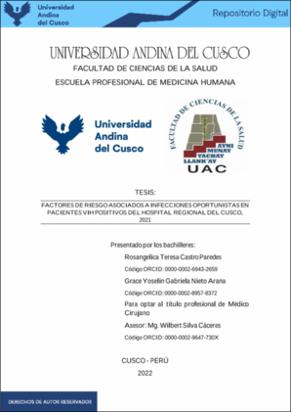| dc.contributor.advisor | Silva Cáceres, Wilbert | |
| dc.contributor.author | Castro Paredes, Rosangelica Teresa | |
| dc.contributor.author | Nieto Arana, Grace Yoselin Gabriela | |
| dc.date.accessioned | 2022-08-26T14:51:26Z | |
| dc.date.available | 2022-08-26T14:51:26Z | |
| dc.date.issued | 2022-08-24 | |
| dc.identifier.uri | https://hdl.handle.net/20.500.12557/4812 | |
| dc.description.abstract | Introducción: Las infecciones oportunistas son todas aquellas patologías que se
desarrollan en individuos con inmunodepresión; como los pacientes portadores de VIH;
causando una importante morbimortalidad. Por esta razón es importante determinar
cuáles son los factores de riesgo que hacen propenso el desarrollo de infecciones
oportunistas. Objetivo: Determinar cuáles son los factores de riesgo asociados en el
desarrollo de infecciones oportunistas en pacientes VIH positivo del Hospital Regional
del Cusco,2021. Materiales y método: El estudio es de tipo correlacional asociativo, de
tipo casos y controles, retrospectivo. El muestreo será por conveniencia; de tipo no
probabilístico para los casos; en lo concerniente al grupo de los controles se realizará un
muestreo aleatorio. Se calculó mediante el programa de Epi Info una muestra de 204
pacientes; siendo 135 controles y 69 casos. Para el análisis de datos se utilizó el programa
estadístico SPSS v.21 Resultados: Los factores de riesgo asociados a infecciones
oportunistas fueron: en factores sociodemográficos: la edad de más de 30 años con un OR
de 2.07, el área de residencia rural con un OR de 1.95 y el trabajar con un OR de 2.33.
De los factores laboratoriales: el conteo de linfocitos T CD4, el estadio IV o conteo de
linfocitos T CD4 menor a 200 cel./ml. Obtuvo un OR de 78.37 en comparación al Estadio
I y la carga viral detectable con un OR 13.7. En los factores personales los hábitos nocivos
tuvieron un OR de 3.67. Dentro los factores terapéuticos: el esquema de tratamiento de
TDF/FTC/EFV con un OR 2.81 en comparación al esquema TDF/3TC/EFV, la no
adherencia al tratamiento con OR de 2.52 y el abandono de tratamiento con un OR de
4.94. Conclusiones: Se encontró como factores de riesgo: a la edad más de 30 años, el
trabajar, el área de residencia rural, el conteo de linfocitos T CD4, la carga viral, los hábitos nocivos, el esquema TDF/FTC/EFV en comparación al esquema TDF/3TC/EFV,
la no adherencia y el abandono al tratamiento. | es_PE |
| dc.description.abstract | Introduction: Opportunistic infections are all those pathologies that develop in
individuals with immunosuppression; such as patients with HIV; causing significant
morbidity and mortality. For this reason, it is important to determine the risk factors that
make the development of opportunistic infections likely. Objective: To determine the
risk factors associated with the development of opportunistic infections in HIV-positive
patients of the Regional Hospital. Materials and method: The study is of the associative
correlational type, case-control type, retrospective. Sampling will be for convenience;
non-probabilistic type for cases; As far as the control group is concerned, random
sampling will be carried out. A sample of 204 patients was calculated using the Epi Info
program; being 136 controls and 68 cases. For data analysis, the statistical program SPSS
v.21 was used. Results: The risk factors associated with opportunistic infections were: in
sociodemographic factors: age over 30 years with an OR of 2.07, the area of rural
residence with an OR of 1.95 and the occupation that works with an OR of 2.33.
Laboratory factors: T CD4 lymphocytes count, stage IV or T CD4 lymphocytes count less
than 200 cells/ml. He obtained an OR of 78.37 compared to Stage I and detectable viral
load with an OR of 13.7. In personal factors, harmful habits had an OR of 3.67. Within
the therapeutic factors: the TDF/FTC/EFV treatment scheme with an OR of 2.81
compared to the TDF/3TC/EFV scheme, non-adherence to treatment with an OR of 2.52
and abandonment of treatment with an OR of 4.94. Conclusions: It was found as risk
factors: age over 30 years, working occupation, rural area of residence, CD4 T
lymphocytes count, viral load, harmful habits, the TDF/FTC/EFV scheme compared to the scheme TDF/3TC/EFV, non-adherence and abandonment of treatment | en_US |
| dc.format | application/pdf | es_PE |
| dc.language.iso | spa | es_PE |
| dc.publisher | Universidad Andina del Cusco | es_PE |
| dc.rights | info:eu-repo/semantics/openAccess | es_PE |
| dc.rights.uri | https://creativecommons.org/licenses/by-nc-nd/4.0/ | es_PE |
| dc.subject | Infecciones oportunistas | es_PE |
| dc.subject | VIH | es_PE |
| dc.subject | Factores de riesgo | es_PE |
| dc.subject | Carga viral | es_PE |
| dc.subject | Conteo de linfocitos T CD4 | es_PE |
| dc.title | Factores de riesgo asociados a infecciones oportunistas en pacientes VIH positivos del Hospital Regional del Cusco, 2021 | es_PE |
| dc.type | info:eu-repo/semantics/bachelorThesis | es_PE |
| thesis.degree.name | Médico Cirujano | es_PE |
| thesis.degree.grantor | Universidad Andina del Cusco. Facultad de Ciencias de la Salud | es_PE |
| thesis.degree.discipline | Medicina Humana | es_PE |
| dc.publisher.country | PE | es_PE |
| dc.subject.ocde | https://purl.org/pe-repo/ocde/ford#3.02.27 | es_PE |
| renati.advisor.dni | 23839399 | |
| renati.advisor.orcid | https://orcid.org/0000-0002-9647-730X | es_PE |
| renati.author.dni | 71821671 | |
| renati.author.dni | 76913277 | |
| renati.discipline | 912016 | es_PE |
| renati.juror | Naveda De Aramburu, Herminia | |
| renati.juror | Zea Nuñez, Carlos Antonio | |
| renati.juror | Jaramillo Corrales, Alex | |
| renati.juror | Rivas Achahui, Cristabel Nilda | |
| renati.level | https://purl.org/pe-repo/renati/level#tituloProfesional | es_PE |
| renati.type | https://purl.org/pe-repo/renati/type#tesis | es_PE |


